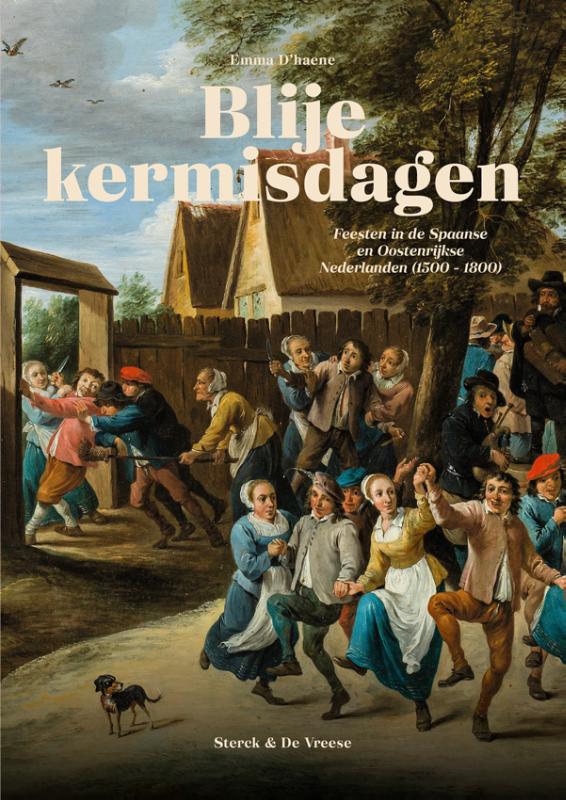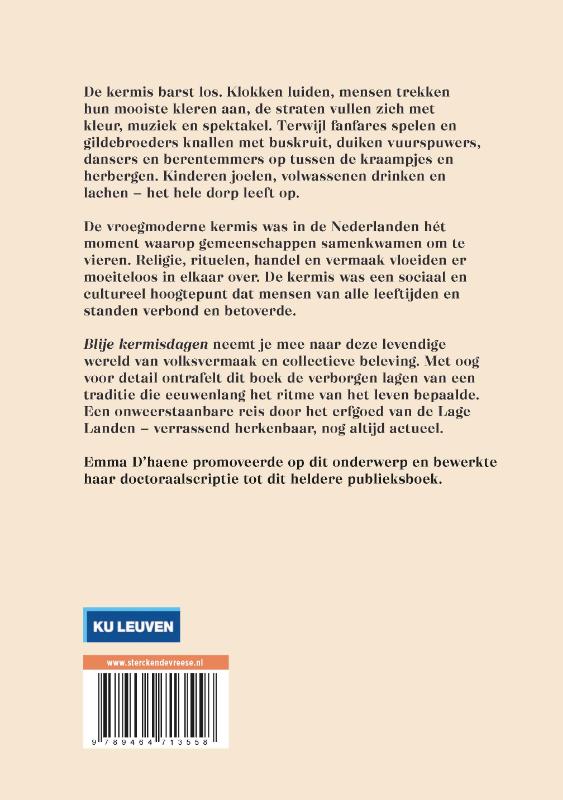Blije kermisdagen
€ 29,90
De kermis barst los. Klokken luiden, mensen trekken hun mooiste kleren aan, de straten vullen zich met kleur, muziek en spektakel. Terwijl fanfares spelen en gildebroeders knallen met buskruit, duiken vuurspuwers, dansers en berentemmers op tussen de kraampjes en herbergen. Kinderen joelen, volwassenen drinken en lachen – het hele dorp leeft op.
De vroegmoderne kermis was in de Nederlanden hét moment waarop gemeenschappen samenkwamen om te vieren. Religie, rituelen, handel en vermaak vloeiden er moeiteloos in elkaar over. De kermis was een sociaal en cultureel hoogtepunt dat mensen van alle leeftijden en standen verbond en betoverde.
Blije kermisdagen neemt je mee naar deze levendige wereld van volksvermaak en collectieve beleving. Met oog voor detail ontrafelt dit boek de verborgen lagen van een traditie die eeuwenlang het ritme van het leven bepaalde. Een onweerstaanbare reis door het erfgoed van de Lage Landen – verrassend herkenbaar, nog altijd actueel.
Emma D’haene promoveerde op dit onderwerp en bewerkte haar doctoraalscriptie tot dit heldere publieksboek.
Deze publicatie is mede mogelijk gemaakt dankzij een bijdrage van het Bijzonder Onderzoeksfonds KU Leuven.
Gerelateerde boeken
-
Fries vlas
€ 34,90Friesland is rond 1880 de grootste producent van vlas in Nederland. De teelt gaat in die jaren niet zozeer om het gewas zelf, maar is voornamelijk bedoeld als werkverschaffing. Het eindproduct linnen wordt veelal thuis en in spinhuizen gesponnen en door regionale wevers verwerkt. Voor veel burgerlijke- en kerkelijke gemeenten in de provincie is het dé manier om arbeiders en hun gezinnen de winter door te helpen. De arbeidsomstandigheden in de zogenoemde braakhokken zijn echter vaak ten hemel schreiend.
Vanaf het begin van de twintigste eeuw verschijnen er in Friesland zo’n twintig fabrieken waarin vlas gemechaniseerd wordt verwerkt. Een van de vele vlasproducten – het lijnzaad – gaat dan een grote rol spelen bij de opkomst van de veevoerindustrie en de intensivering van de landbouw.In deze rijk geïllustreerde uitgave beschrijven Henk Dijkstra en Gerrit Herrema de Friese vlasgeschiedenis. Hoe en waar werd in Friesland vlas verbouwd, hoe werd het verwerkt, welke producten leverde het op en hoe was de afzet geregeld. Dit boek bevat een overzicht van veel gebruikte vlasserstermen in zowel het Fries als in het Nederlands. De auteurs sluiten af met de recente ontwikkelingen binnen de vlasteelt en de toekomstmogelijkheden voor Fries vlas.
-
Onderweg naar 1832
€ 22,50Onderweg naar 1832 vertelt het verhaal van zes jonge mensen uit eenvoudige milieus, met ieder een bijzondere geschiedenis. Twee vrouwen en vier mannen, van wie één met Joodse migrantenwortels. Het speelt tegen de achtergrond van de schoolwereld uit de vroege negentiende eeuw en loopt vanaf hun kindertijd tot 1832. In dat jaar waren ze als dertigers aanwezig op een legendarisch jubileumfeest ter ere van hun onderwijsinspecteur. Ze hadden toen, gegeven hun afkomst en sekse, binnen het onderwijs opvallend carrière gemaakt. Op basis van historische bronnen laat het boek zien hoe dit kwam en wat ze onderweg naar 1832 meemaakten.
Samen geven de zes biografische verhalen een beeld van vroege ontwikkelingen binnen het lerarenberoep. Onderwijsvernieuwing was in deze periode het sleutelwoord. Geleidelijk nam daardoor de vakbekwaamheid toe, verbeterden de arbeidsomstandigheden en steeg het sociale aanzien van de beroepsgroep – maar alleen voor de mannen. Het boek maakt ook de onontkoombare man-vrouw verschillen van deze periode zichtbaar.
De jonge levens van de zes speelden zich grotendeels af in de stad Groningen, toen een belangrijk centrum van onderwijsvernieuwing. Ze stonden in de voorhoede van de nieuwe Nederlandse school. Het boek vertelt de nauw met elkaar verweven verhalen over deze bijzondere pioniers: een idealistische dovenonderwijzer, de ontwerper van de pabo, Nederlands eerste kleuterpedagoge, een talenvirtuoos die botste op de grenzen van de tolerantie, een heel vroege carrièrevrouw, en de wegbereider van de Algemene Onderwijsbond (AOb). Ingekleurde momentopnamen van opvallende gebeurtenissen in hun bestaan – een dramatische vergadering, een liefde, een stedentripje naar Amsterdam, een onvergetelijke les – brengen de personen tot leven. Een bijzondere combinatie van feiten en fictie.
Mineke van Essen is historisch pedagoog en emeritus hoogleraar van de Rijksuniversiteit Groningen.
-





